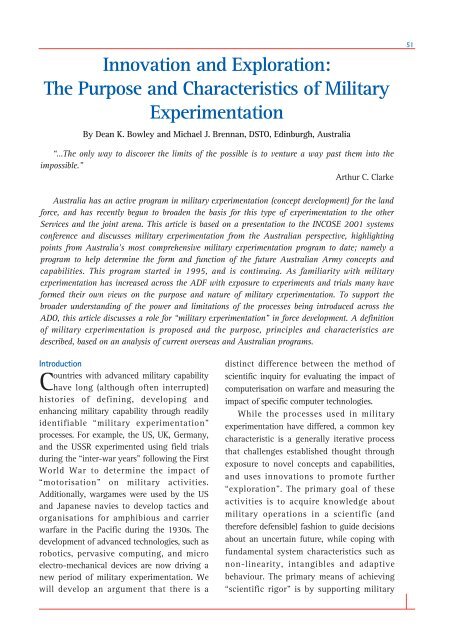ISSUE 152 : Jan/Feb - 2002 - Australian Defence Force Journal
ISSUE 152 : Jan/Feb - 2002 - Australian Defence Force Journal
ISSUE 152 : Jan/Feb - 2002 - Australian Defence Force Journal
- No tags were found...
Create successful ePaper yourself
Turn your PDF publications into a flip-book with our unique Google optimized e-Paper software.
Innovation and Exploration:The Purpose and Characteristics of MilitaryExperimentationBy Dean K. Bowley and Michael J. Brennan, DSTO, Edinburgh, Australia51“…The only way to discover the limits of the possible is to venture a way past them into theimpossible.”Arthur C. ClarkeAustralia has an active program in military experimentation (concept development) for the landforce, and has recently begun to broaden the basis for this type of experimentation to the otherServices and the joint arena. This article is based on a presentation to the INCOSE 2001 systemsconference and discusses military experimentation from the <strong>Australian</strong> perspective, highlightingpoints from Australia's most comprehensive military experimentation program to date; namely aprogram to help determine the form and function of the future <strong>Australian</strong> Army concepts andcapabilities. This program started in 1995, and is continuing. As familiarity with militaryexperimentation has increased across the ADF with exposure to experiments and trials many haveformed their own views on the purpose and nature of military experimentation. To support thebroader understanding of the power and limitations of the processes being introduced across theADO, this article discusses a role for “military experimentation” in force development. A definitionof military experimentation is proposed and the purpose, principles and characteristics aredescribed, based on an analysis of current overseas and <strong>Australian</strong> programs.IntroductionCountries with advanced military capabilityhave long (although often interrupted)histories of defining, developing andenhancing military capability through readilyidentifiable “military experimentation”processes. For example, the US, UK, Germany,and the USSR experimented using field trialsduring the “inter-war years” following the FirstWorld War to determine the impact of“motorisation” on military activities.Additionally, wargames were used by the USand Japanese navies to develop tactics andorganisations for amphibious and carrierwarfare in the Pacific during the 1930s. Thedevelopment of advanced technologies, such asrobotics, pervasive computing, and microelectro-mechanical devices are now driving anew period of military experimentation. Wewill develop an argument that there is adistinct difference between the method ofscientific inquiry for evaluating the impact ofcomputerisation on warfare and measuring theimpact of specific computer technologies.While the processes used in militaryexperimentation have differed, a common keycharacteristic is a generally iterative processthat challenges established thought throughexposure to novel concepts and capabilities,and uses innovations to promote further“exploration”. The primary goal of theseactivities is to acquire knowledge aboutmilitary operations in a scientific (andtherefore defensible) fashion to guide decisionsabout an uncertain future, while coping withfundamental system characteristics such asnon-linearity, intangibles and adaptivebehaviour. The primary means of achieving“scientific rigor” is by supporting military
















